The Effect of Language Contact on /tʃ/ Deaffrication in Spanish from the US–Mexico Borderland
Abstract
1. Introduction
2. Background Literature
2.1. /ʧ/ Deaffrication
2.2. Sociolinguistic Studies on /tʃ/ Deaffrication
2.3. L2 Influence on the Perception and Production of L1 Sounds
3. Research Questions and Hypotheses
- (i)
- Can contact with English affect L1 /tʃ/ deaffrication in sequential and simultaneous bilinguals from Chihuahua and El Paso?
- (ii)
- Are AOA and LOR effective predictors of L2-on-L1 influence?
- (iii)
- Does proficiency and frequency of use of the L2 affect L1 variation?
- (iv)
- What sociolinguistic (linguistic or extra-linguistic) factors play a role on /ʧ/ deaffrication in each group? Does the patterning of factors that influence the variability in bilingual speech mirror that of monolingual speech?
4. The Present Study
4.1. Participants
4.2. Materials
4.3. Spectrographic Inspection of Tokens and Coding
4.4. Statistical Analyses
5. Results
6. Discussion and Conclusions
Supplementary Materials
Funding
Institutional Review Board Statement
Informed Consent Statement
Data Availability Statement
Acknowledgments
Conflicts of Interest
Appendix A
| Contingency Tables | ||||
| Variant | ||||
| Speaker | [tʃ] | [ʃ] | Total | |
| UT001 | N | 10 | 1 | 11 |
| % | 1.5% | 0.1% | 1.6% | |
| UT002 | N | 13 | 0 | 13 |
| % | 1.9% | 0.0% | 1.9% | |
| UT005 | N | 4 | 3 | 7 |
| % | 0.6% | 0.4% | 1.0% | |
| UT006 | N | 10 | 2 | 12 |
| % | 1.5% | 0.3% | 1.8% | |
| UT007 | N | 20 | 0 | 20 |
| % | 2.9% | 0.0% | 2.9% | |
| UT008 | N | 12 | 0 | 12 |
| % | 1.8% | 0.0% | 1.8% | |
| UT014 | N | 3 | 0 | 3 |
| % | 0.4% | 0.0% | 0.4% | |
| UT016 | N | 14 | 0 | 14 |
| % | 2.1% | 0.0% | 2.1% | |
| UT017 | N | 8 | 1 | 9 |
| % | 1.2% | 0.1% | 1.3% | |
| UT019 | N | 11 | 1 | 12 |
| % | 1.6% | 0.1% | 1.8% | |
| UT022 | N | 6 | 0 | 6 |
| % | 0.9% | 0.0% | 0.9% | |
| UT024 | N | 7 | 0 | 7 |
| % | 1.0% | 0.0% | 1.0% | |
| UT025 | N | 5 | 0 | 5 |
| % | 0.7% | 0.0% | 0.7% | |
| UT026 | N | 23 | 0 | 23 |
| % | 3.4% | 0.0% | 3.4% | |
| UT027 | N | 6 | 2 | 8 |
| % | 0.9% | 0.3% | 1.2% | |
| UT030 | N | 21 | 5 | 26 |
| % | 3.1% | 0.7% | 3.8% | |
| UT031 | N | 10 | 0 | 10 |
| % | 1.5% | 0.0% | 1.5% | |
| UT032 | N | 30 | 1 | 31 |
| % | 4.4% | 0.1% | 4.6% | |
| UT034 | N | 1 | 16 | 17 |
| % | 0.1% | 2.3% | 2.5% | |
| UT035 | N | 34 | 0 | 34 |
| % | 5.0% | 0.0% | 5.0% | |
| UT036 | N | 1 | 15 | 16 |
| % | 0.1% | 2.2% | 2.3% | |
| UT037 | N | 3 | 9 | 12 |
| % | 0.4% | 1.3% | 1.8% | |
| UT038 | 29 | 13 | 42 | |
| % | 4.3% | 1.9% | 6.2% | |
| UT039 | N | 0 | 18 | 18 |
| % | 0.0% | 2.6% | 2.6% | |
| UT040 | N | 1 | 10 | 11 |
| % | 0.1% | 1.5% | 1.6% | |
| UT047 | N | 31 | 0 | 31 |
| % | 4.6% | 0.0% | 4.6% | |
| UT050 | N | 12 | 0 | 12 |
| % | 1.8% | 0.0% | 1.8% | |
| UT052 | N | 24 | 2 | 26 |
| % | 3.5% | 0.3% | 3.8% | |
| UT053 | N | 8 | 0 | 8 |
| % | 1.2% | 0.0% | 1.2% | |
| UT054 | N | 7 | 10 | 17 |
| % | 1.0% | 1.5% | 2.5% | |
| UT057 | N | 5 | 11 | 16 |
| % | 0.7% | 1.6% | 2.3% | |
| UT078 | N | 11 | 0 | 11 |
| % | 1.6% | 0.0% | 1.6% | |
| UT079 | N | 32 | 0 | 32 |
| % | 4.7% | 0.0% | 4.7% | |
| UT081 | N | 11 | 0 | 11 |
| % | 1.6% | 0.0% | 1.6% | |
| UT086 | N | 18 | 0 | 18 |
| % | 2.6% | 0.0% | 2.6% | |
| UT107 | N | 15 | 0 | 15 |
| % | 2.2% | 0.0% | 2.2% | |
| UT108 | N | 10 | 1 | 11 |
| % | 1.5% | 0.1% | 1.6% | |
| UTCJ1 | N | 3 | 6 | 9 |
| % | 0.4% | 0.9% | 1.3% | |
| UTCJ3 | N | 9 | 15 | 24 |
| % | 1.3% | 2.2% | 3.5% | |
| UTCJ4 | N | 1 | 10 | 11 |
| % | 0.1% | 1.5% | 1.6% | |
| UTCJ5 | N | 13 | 1 | 14 |
| % | 1.9% | 0.1% | 2.1% | |
| UTCJ6 | N | 18 | 0 | 18 |
| % | 2.6% | 0.0% | 2.6% | |
| UTCJ7 | N | 3 | 6 | 9 |
| % | 0.4% | 0.9% | 1.3% | |
| UTCJ8 | N | 8 | 1 | 9 |
| % | 1.2% | 0.1% | 1.3% | |
| Total | N | 521 | 160 | 681 |
| % | 76.5% | 23.5% | 100.0% | |
Appendix B
| Variant | ||||
|---|---|---|---|---|
| Preceding Collapsed | [tʃ] | [ʃ] | Total | |
| Pause | N | 32 | 8 | 40 |
| % | 80.0% | 20.0% | 100.0% | |
| a | N | 19 | 2 | 21 |
| % | 90.5% | 9.5% | 100.0% | |
| ei | N | 205 | 54 | 259 |
| % | 79.2% | 20.8% | 100.0% | |
| l | N | 19 | 7 | 26 |
| % | 73.1% | 26.9% | 100.0% | |
| n | N | 56 | 2 | 58 |
| % | 96.6% | 3.4% | 100.0% | |
| ou | N | 173 | 82 | 255 |
| % | 67.8% | 32.2% | 100.0% | |
| r | N | 3 | 0 | 3 |
| % | 100.0% | 0.0% | 100.0% | |
| s | N | 14 | 5 | 19 |
| % | 73.7% | 26.3% | 100.0% | |
| Total | N | 521 | 160 | 681 |
| % | 76.5% | 23.5% | 100.0% | |

References
- Amastae, Jon. 1996. Variación y Cambio en el Español de Ciudad Juárez. Cd Juárez: Universidad Autónoma de Ciudad Juárez. [Google Scholar]
- Amengual, Mark. 2012. Interlingual influence in bilingual speech: Cognate status effect in a continuum of bilingualism. Bilingualism: Language and Cognition 15: 517–30. [Google Scholar] [CrossRef]
- Antoniou, Mark, Michael D. Tyler, and Catherine T. Best. 2012. Two ways to listen: Do L2-dominant bilinguals perceive stop voicing according to language mode? Journal of Phonetics 40: 582–94. [Google Scholar] [CrossRef] [PubMed]
- Au, Terry Kit-fong, Leah M. Knightly, Sun-Ah Jun, and Janet S. Oh. 2002. Overhearing a language during childhood. Psychological Science 13: 238–43. [Google Scholar] [CrossRef]
- Best, Catherine T., and Michael D. Tyler. 2007. Nonnative and second-language speech. In Language Experience in Second Language Speech Learning: In Honor of James Emil Flege. Amsterdam and Philadelphia: John Benjamins Publishing, vol. 17, pp. 13–34. [Google Scholar]
- Boersma, Paul, and David Weenink. 2021. Praat: Doing Phonetics by Computer [Computer Program]. Version 6.1.439. Available online: http://www.praat.org/ (accessed on 8 February 2021).
- Bourdieu, Pierre, and Luc Boltanski. 1975. Le fétichisme de la langue. Actes de la Recherche en Sciences Sociales 1: 2–32. [Google Scholar] [CrossRef]
- Brown, Dolores. 1989. El habla juvenil de Sonora, México: La fonética de 32 jóvenes. Nueva Revista de Filología Hispánica 37: 43–82. [Google Scholar] [CrossRef]
- Cedergren, Henrietta Cecilia Jonas. 1973. The Interplay of Social and Linguistic Factors in Panama. Ithaca: Cornell University. [Google Scholar]
- Chang, Charles B. 2011. Rapid and multifaceted effects of second-language learning on first-language speech production. Journal of Phonetics 40: 249–68. [Google Scholar] [CrossRef]
- Cuza, Alejandro, Ana Teresa Pérez-Leroux, and Liliana Sánchez. 2013. The role of semantic transfer in clitic drop among simultaneous and sequential Chinese-Spanish bilinguals. Studies in Second Language Acquisition 35: 93–125. [Google Scholar] [CrossRef]
- Fernández, Leticia, Cheryl Howard, and Jon Amastae. 2007. Education, race/ethnicity and out-migration from a border city. Population Research and Policy Review 26: 103–24. [Google Scholar] [CrossRef]
- Fischer, John L. 1958. Social influences on the choice of a linguistic variant. Word 14: 47–56. [Google Scholar] [CrossRef]
- Flege, James E. 1995. Second language speech learning: Theory, findings, and problems. Speech Perception and Linguistic Experience: Issues in Cross-Language Research 92: 233–77. [Google Scholar]
- Flege, James Emil, and Ocke-Schwen Bohn. 2021. The revised speech learning model (SLM-r). In Second Language Speech Learning: Theoretical and Empirical Progress. Cambridge: Cambridge University Press, pp. 3–83. [Google Scholar]
- Grosjean, François. 1989. Neurolinguists, beware! The bilingual is not two monolinguals in one person. Brain and Language 36: 3–15. [Google Scholar] [CrossRef]
- Grosjean, François. 1998. Studying bilinguals: Methodological and conceptual issues. Bilingualism: Language and Cognition 1: 131–49. [Google Scholar] [CrossRef]
- Herrera, Z. Esther. 2006. El debilitamiento de /t∫/ en dos variedades del español americano. Nueva Revista de Filología Hispánica 54: 557–69. [Google Scholar] [CrossRef][Green Version]
- Hidalgo, Margarita. 1995. Language and ethnicity in the” taboo” region: The US-Mexico border. International Journal of the Sociology of Language 114: 29–46. [Google Scholar] [CrossRef]
- Hualde, José Ignacio. 2005. The Sounds of Spanish with Audio CD. Cambridge: Cambridge University Press. [Google Scholar]
- Jaramillo, June A., and Garland D. Bills. 1982. The phoneme /ch/ in the Spanish of Tomé, New Mexico. In Bilingualism and Language Contact: Spanish, English, and Native American Languages. Bilingual Education Series. New York: Teachers College Press, pp. 154–65. [Google Scholar]
- Krogstad, Jens Manuel, and Mark Hugo Lopez. 2017. Use of Spanish Declines among Latinos in Major US Metros. Washington, DC: Pew Research Center, October 31, Available online: https://www.pewresearch.org/fact-tank/2017/10/31/use-of-spanish-declines-among-latinos-in-major-u-s-metros/#:~:text=But%20while%20the%20number%20of,to%20a%20Pew%20Research%20Center (accessed on 29 August 2021).
- Labov, William. 1972. Sociolinguistic Patterns. No. 4. Philadelphia: University of Pennsylvania Press. [Google Scholar]
- López Velarde, Mariela, and Miquel Simonet. 2020. The Perception of Postalveolar English Obstruents by Spanish Speakers Learning English as a Foreign Language in Mexico. Languages 5: 27. [Google Scholar] [CrossRef]
- Lubbers, Mart, and Francisco Torreira. 2016. Praatalign: An Interactive Praat Plug-In for Performing Phonetic Forced Alignment. A Detailed Manual for Version 1.8. Available online: https://github.com/dopefishh/praatalign (accessed on 29 August 2021).
- Mazzaro, Natalia, and Raquel González de Anda. 2019. The perception-production connection:/tʃ/deaffrication and rhotic assibilation in Chihuahua Spanish. In Issues in Hispanic and Lusophone Linguistics Series: Recent Advances in the Study of Spanish Sociophonetic Perception. Edited by Whitney Chappell. Amsterdam: John Benjamins Publishing Company, pp. 288–311. [Google Scholar]
- Mazzaro, Natalia, Laura Colantoni, and Alejandro Cuza. 2016. Age effects and the discrimination of consonantal and vocalic contrasts in heritage and native Spanish. In Romance Linguistics 2013: Selected Proceedings of the 43th Linguistic Symposium on Romance Languages, New York, NY, USA, April 17–19, 2013. Edited by Christina Tortora, Marcel den Dikken, Ignacio L. Montoya and Teresa O’Neill. Amsterdam: John Benjamins, pp. 277–300. [Google Scholar]
- Méndez, Luis Alberto. 2017. The variant [ʃ] in the Spanish of Ciudad Juárez. Borealis—An International Journal of Hispanic Linguistics 6: 243–60. [Google Scholar] [CrossRef]
- Menke, Mandy R., and Timothy L. Face. 2010. Second language Spanish vowel production: An acoustic analysis. Studies in Hispanic and Lusophone Linguistics 3: 181–214. [Google Scholar] [CrossRef]
- Montrul, Silvina. 2010. Current issues in heritage language acquisition. Annual Review of Applied Linguistics 30: 3–23. [Google Scholar] [CrossRef]
- R Core Team. 2020. R: A Language and Environment for Statistical Computing. (Version 4.0) [Computer Software]. R Packages Retrieved from MRAN Snapshot. Available online: https://cran.r-project.org (accessed on 24 August 2020).
- Regan, Brendan. 2020. El [ʃ]oquero: /tʃ/ Variation in Huelva Capital and Surrounding Towns. Estudios de Fonética Experimental 29: 55–90. [Google Scholar]
- Romaine, Suzanne. 1980. Stylistic variation and evaluative reactions to speech: Problems in the investigation of linguistic attitudes in Scotland. Language and Speech 23: 213–32. [Google Scholar] [CrossRef]
- Strobl, Carolin, Anne-Laure Boulesteix, Thomas Kneib, Thomas Augustin, and Achim Zeileis. 2008. Conditional variable importance for random forests. BMC Bioinformatics 9: 307. [Google Scholar] [CrossRef] [PubMed]
- Tagliamonte, Sali, and Harald Baayen. 2012. Models, forests and trees of York English: Was/were variation as a case study for statistical practice. Language Variation and Change 24: 135–78. [Google Scholar] [CrossRef]
- The Jamovi Project. 2021. Jamovi. (Version 1.6) [Computer Software]. Available online: https://www.jamovi.org (accessed on 26 April 2021).
- U.S. Census Bureau. 2019. Quick Facts: El Paso County, Texas. Available online: https://www.census.gov/quickfacts/elpasocountytexas (accessed on 10 July 2021).
- Yeni-Komshian, Grace H., James E. Flege, and Serena Liu. 2000. Pronunciation proficiency in the first and second languages of Korean–English bilinguals. Bilingualism: Language and Cognition 3: 131–49. [Google Scholar] [CrossRef]
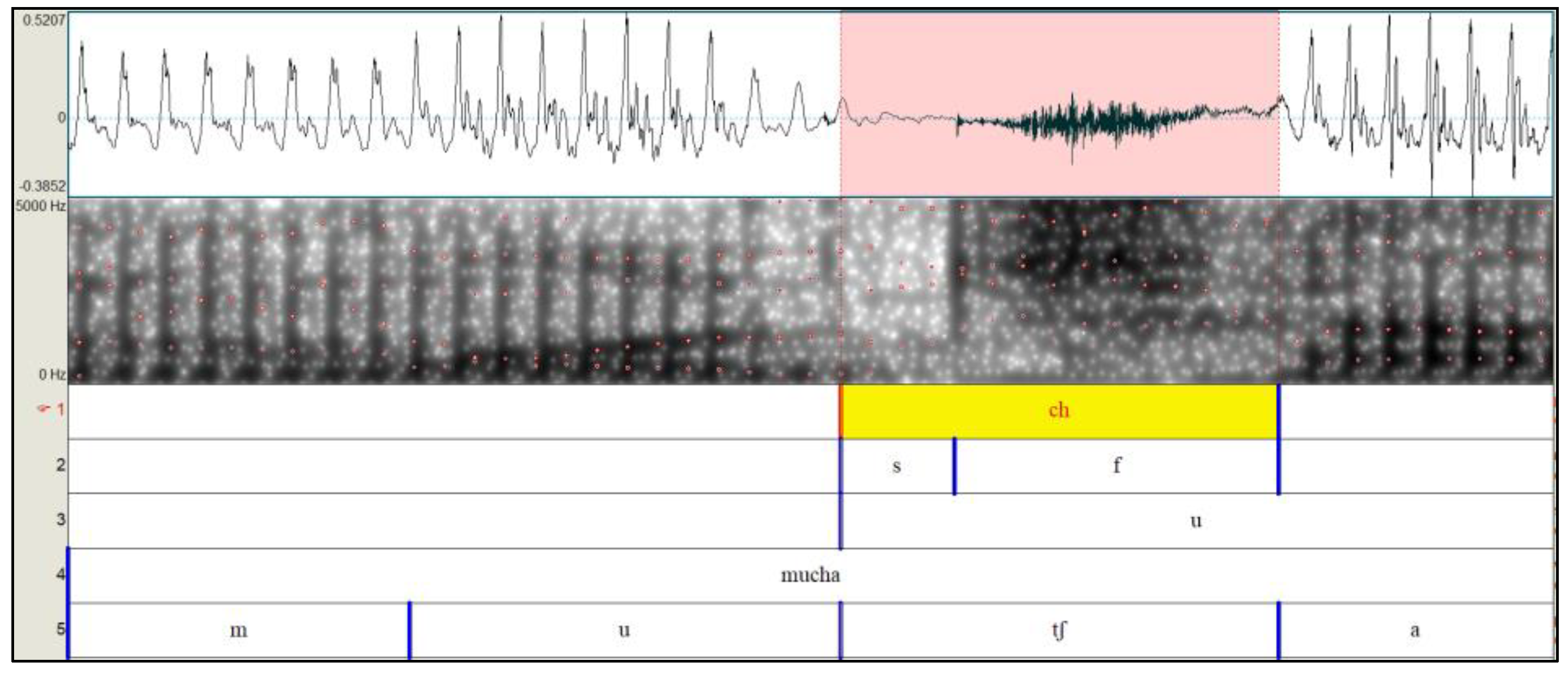
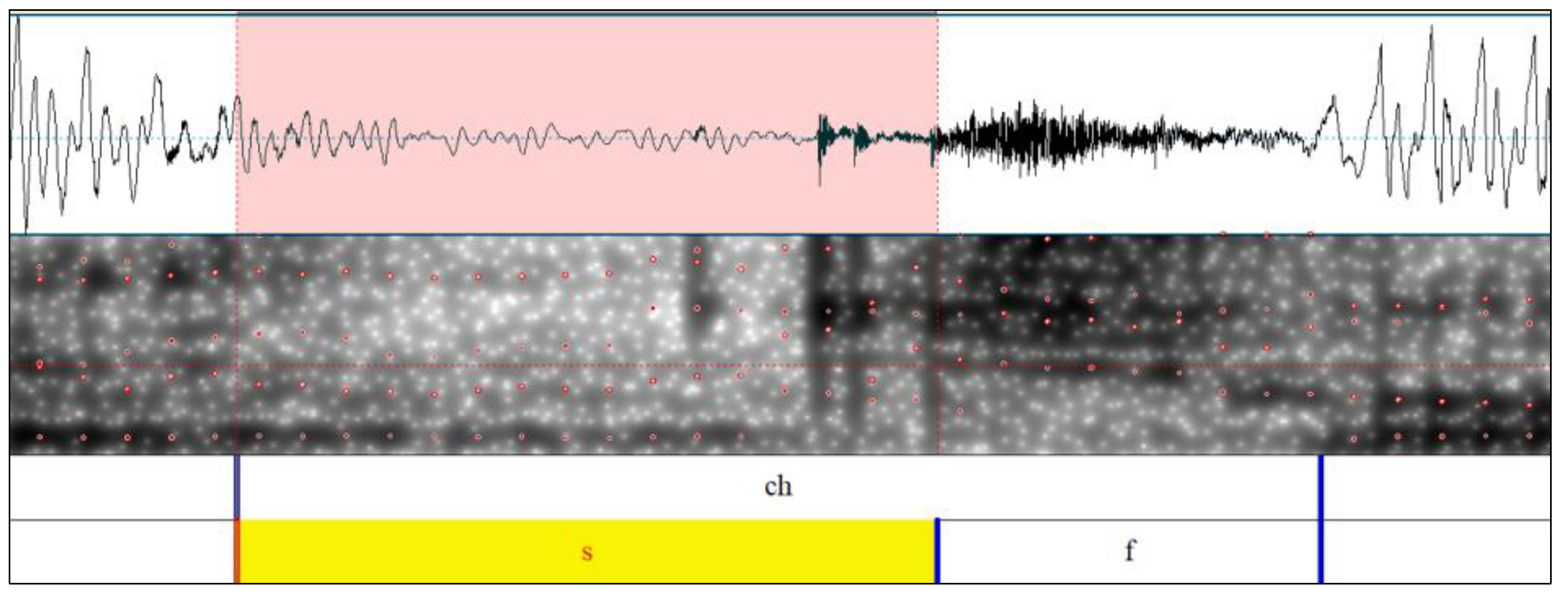
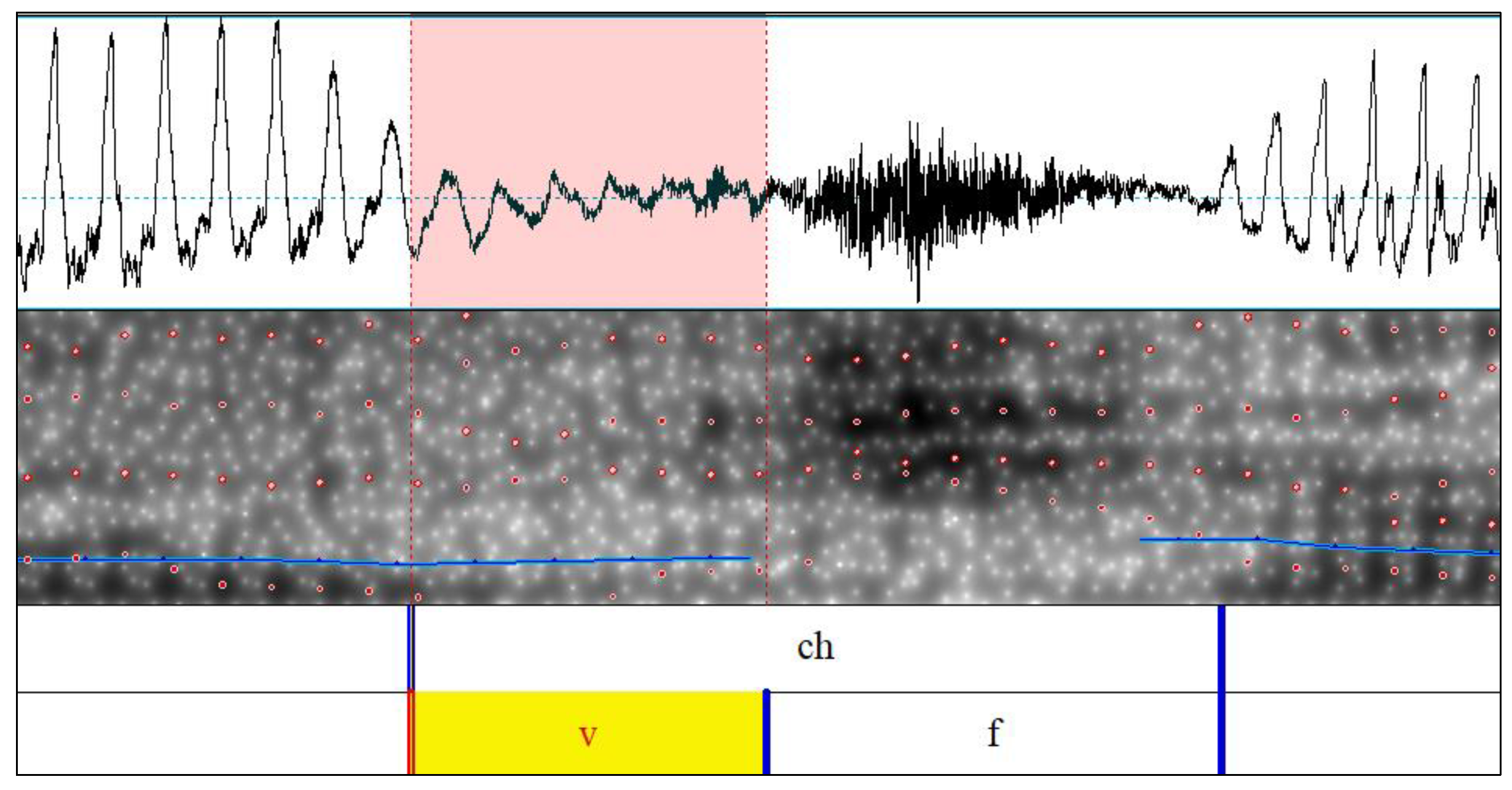
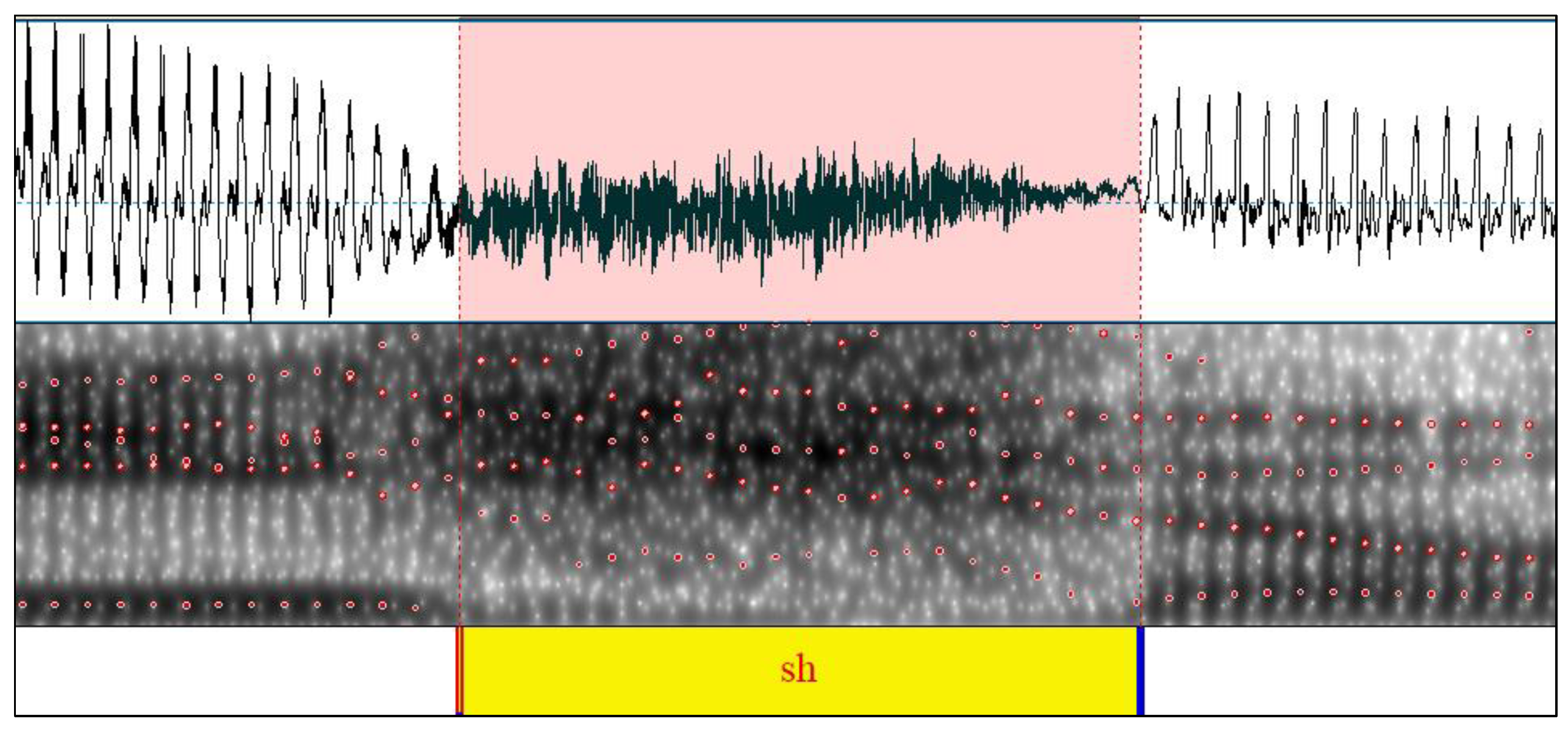
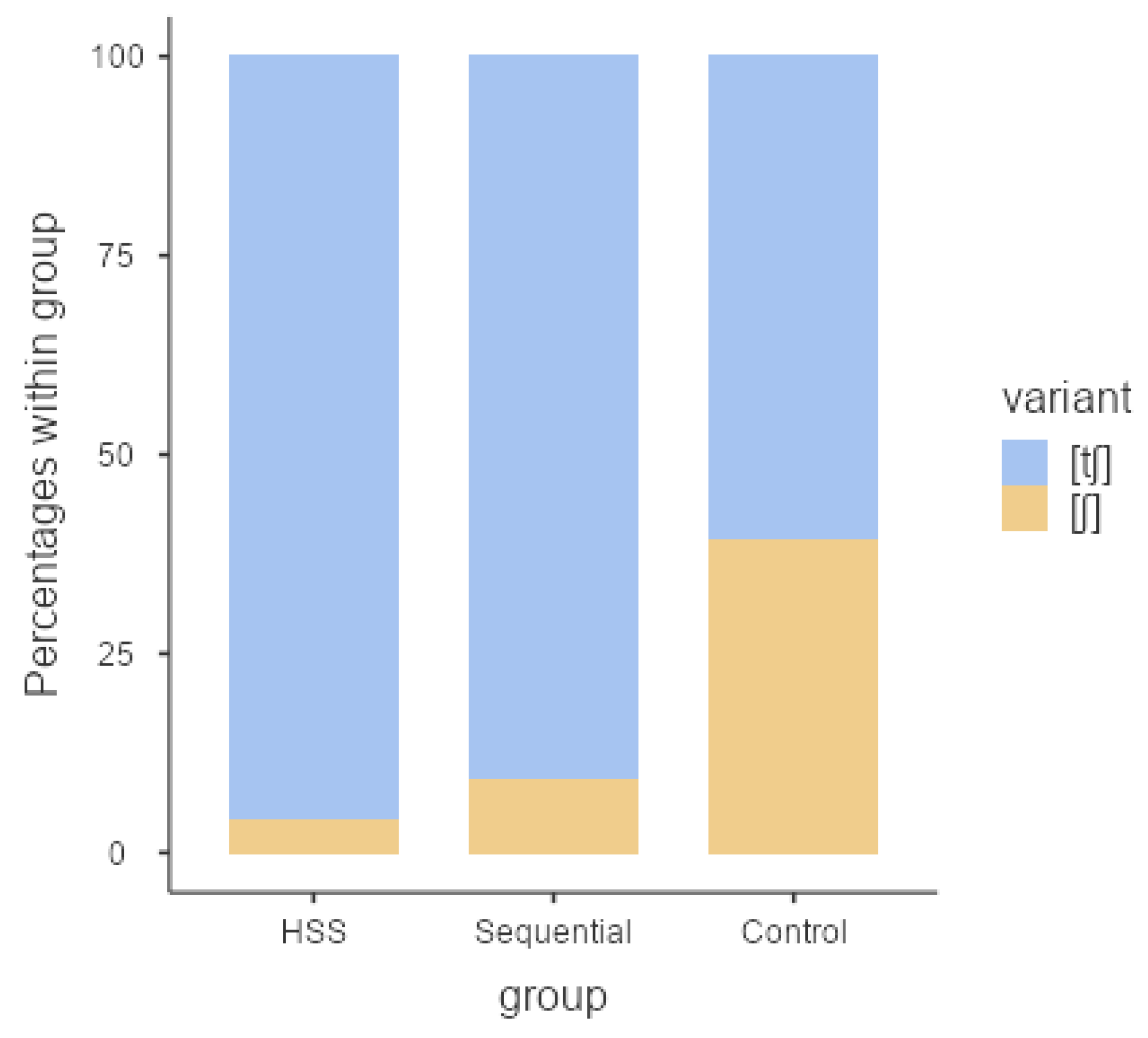
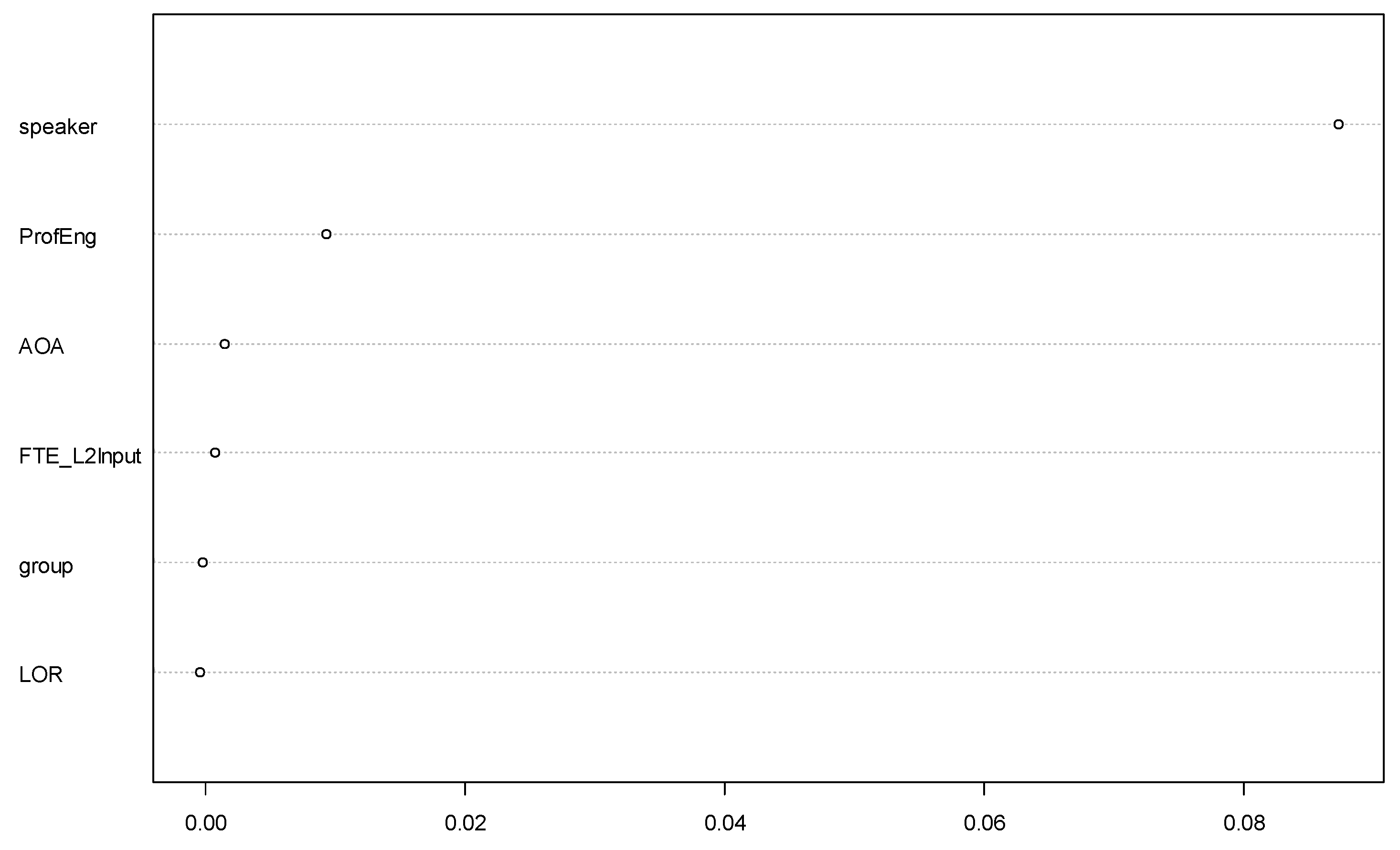
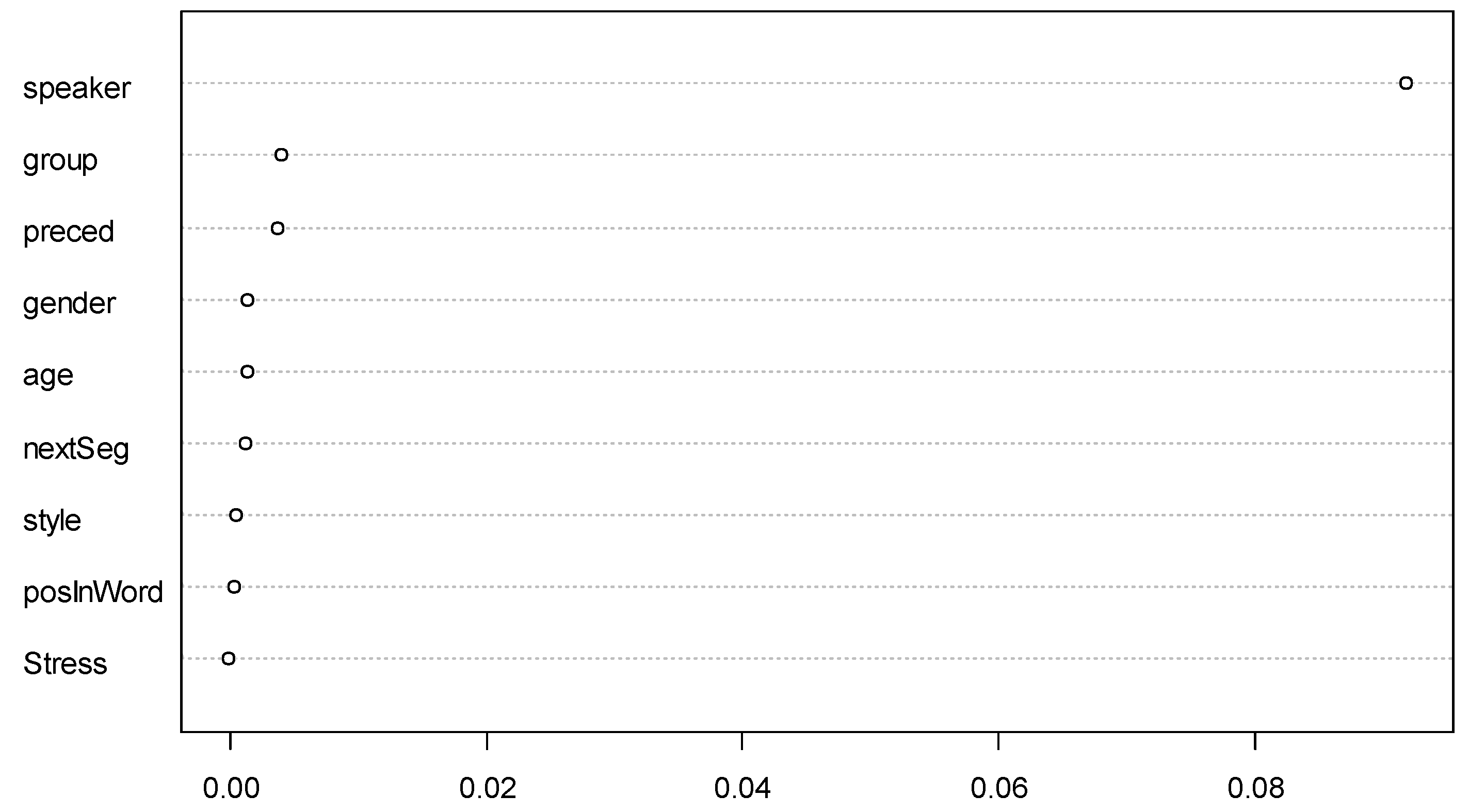
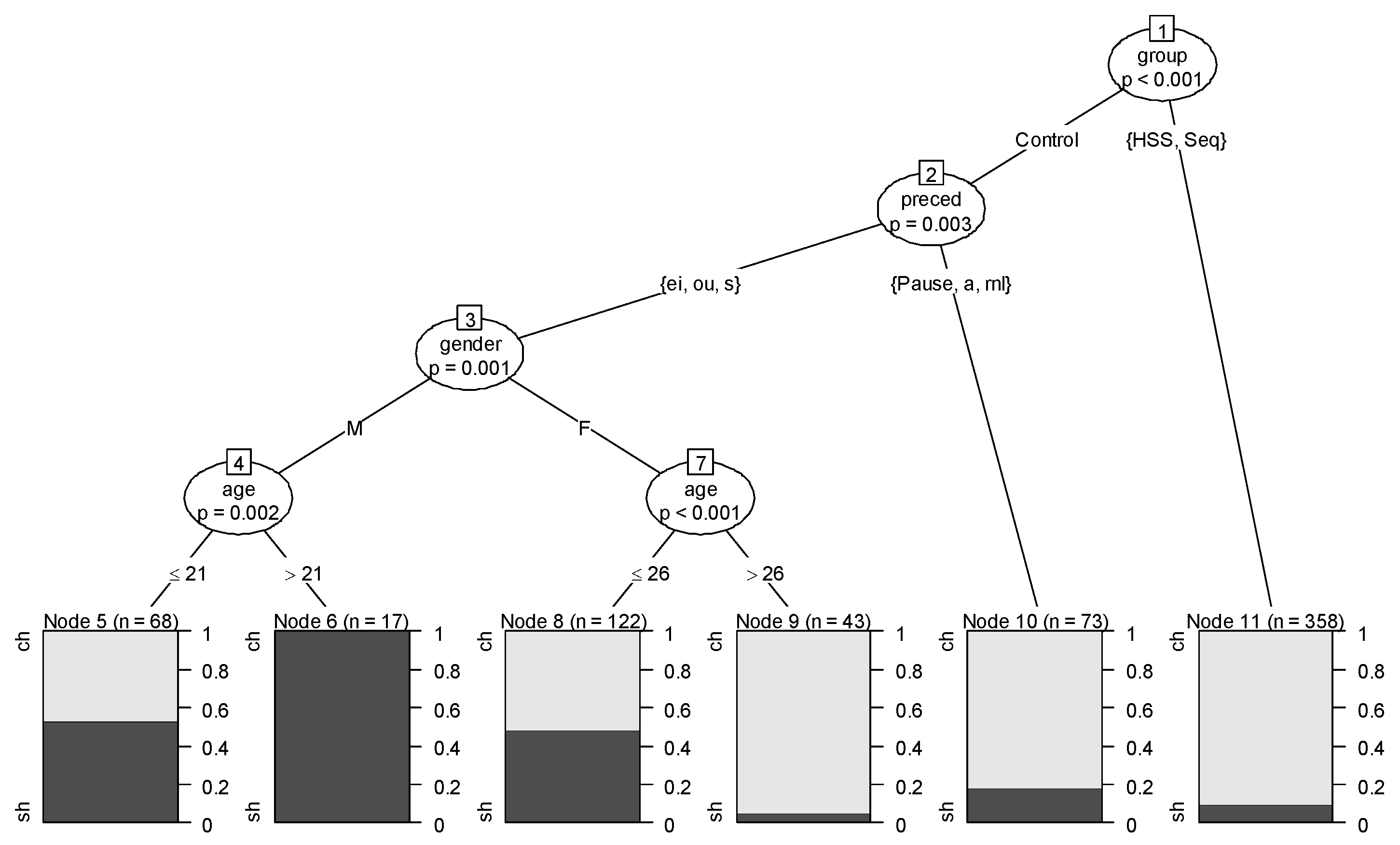
| HSS (n = 14) | Sequential (n = 12) | Control (n = 18) | ||||
|---|---|---|---|---|---|---|
| Mean age at testing (SD) | 22.9 (2.77) | 39.9 (15.1) | 24.7 (9.99) | |||
| Place of birth | US & Mexico | US & Mexico | Mexico | |||
| Mean AOA 1 in the USA | 3.7 | 28.6 | 24.2 | |||
| Overall Lg. 2 Use | 3.5/7 | 4.9/7 | - | |||
| Gender | F 6 | M 8 | F 10 | M 2 | F 12 | M 6 |
| DELE 3 | 42/50 | 46/50 | - | |||
| Mean LOR 4 | MX 3.7 | USA 19.1 | MX 28.7 | USA 11.3 | MX 24.1 | US 0.4 |
| Self-Proficiency (out of 4) | Eng. 3.7 | Span. 3 | Eng. 2.7 | Span. 3.9 | - | |
| More Comfortable Lg. 2 | Spa 8% | Eng. 46% | Spa. 91.7% | Eng. 8.3% | Spa. 100% | |
| Both 46% | Both - | |||||
| Variant | ||||
|---|---|---|---|---|
| Group | [tʃ] | [ʃ] | Total | |
| HSS | N | 161 | 7 | 168 |
| % | 95.8% | 4.2% | 100.0% | |
| Sequential | N | 157 | 16 | 173 |
| % | 90.8% | 9.2% | 100.0% | |
| Control | N | 196 | 127 | 323 |
| % | 60.7% | 39.3% | 100.0% | |
| Total | N | 514 | 150 | 664 |
| % | 77.4% | 22.6% | 100.0% | |
Publisher’s Note: MDPI stays neutral with regard to jurisdictional claims in published maps and institutional affiliations. |
© 2022 by the author. Licensee MDPI, Basel, Switzerland. This article is an open access article distributed under the terms and conditions of the Creative Commons Attribution (CC BY) license (https://creativecommons.org/licenses/by/4.0/).
Share and Cite
Mazzaro, N. The Effect of Language Contact on /tʃ/ Deaffrication in Spanish from the US–Mexico Borderland. Languages 2022, 7, 101. https://doi.org/10.3390/languages7020101
Mazzaro N. The Effect of Language Contact on /tʃ/ Deaffrication in Spanish from the US–Mexico Borderland. Languages. 2022; 7(2):101. https://doi.org/10.3390/languages7020101
Chicago/Turabian StyleMazzaro, Natalia. 2022. "The Effect of Language Contact on /tʃ/ Deaffrication in Spanish from the US–Mexico Borderland" Languages 7, no. 2: 101. https://doi.org/10.3390/languages7020101
APA StyleMazzaro, N. (2022). The Effect of Language Contact on /tʃ/ Deaffrication in Spanish from the US–Mexico Borderland. Languages, 7(2), 101. https://doi.org/10.3390/languages7020101





